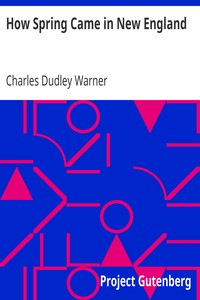How Spring Came in New England by Charles Dudley Warner
"How Spring Came in New England" by Charles Dudley Warner is a reflective and humorous essay that delves into the unpredictable nature of spring in New England, written during the late 19th century. This work blends elements of observational writing and natural philosophy as it explores the transitions between winter and spring in this region, vividly capturing the climatological complexities and the emotional responses they evoke in the local populace. In the
book, Warner personifies the struggle between winter and spring, illustrating how this seasonal battle affects both nature and the human spirit. He elegantly describes the gradual thaw, the return of vegetation, and the emergence of wildlife, while simultaneously conveying the treachery of spring storms that can suddenly revert the landscape back to wintry despair. Humor and irony abound as he recounts the hopes of New Englanders for a gentle spring, only to have them dashed by an unexpected snowstorm or a chilling wind. Ultimately, Warner captures the essence of life in New England, where the relentless cycle of nature becomes a metaphor for human resilience and the perpetual hope that colors the human experience. (This is an automatically generated summary.)
Read or download for free
| How to read | Url | Size | |||
|---|---|---|---|---|---|
| Read now! | https://www.gutenberg.org/ebooks/3131.html.images | 56 kB | |||
| EPUB3 (E-readers incl. Send-to-Kindle) | https://www.gutenberg.org/ebooks/3131.epub3.images | 107 kB | |||
| EPUB (older E-readers) | https://www.gutenberg.org/ebooks/3131.epub.images | 106 kB | |||
| EPUB (no images, older E-readers) | https://www.gutenberg.org/ebooks/3131.epub.noimages | 86 kB | |||
| Kindle | https://www.gutenberg.org/ebooks/3131.kf8.images | 234 kB | |||
| older Kindles | https://www.gutenberg.org/ebooks/3131.kindle.images | 228 kB | |||
| Plain Text UTF-8 | https://www.gutenberg.org/ebooks/3131.txt.utf-8 | 47 kB | |||
| Download HTML (zip) | https://www.gutenberg.org/cache/epub/3131/pg3131-h.zip | 108 kB | |||
| There may be more files related to this item. | |||||
Similar Books
About this eBook
| Author | Warner, Charles Dudley, 1829-1900 |
|---|---|
| Title | How Spring Came in New England |
| Note | Reading ease score: 83.5 (6th grade). Easy to read. |
| Credits | Produced by David Widger |
| Language | English |
| LoC Class | PS: Language and Literatures: American and Canadian literature |
| Subject | Spring |
| Subject | Adirondack Mountains (N.Y.) -- Description and travel |
| Subject | New England -- Climate |
| Category | Text |
| EBook-No. | 3131 |
| Release Date | Oct 10, 2004 |
| Most Recently Updated | Jan 27, 2021 |
| Copyright Status | Public domain in the USA. |
| Downloads | 164 downloads in the last 30 days. |
| Project Gutenberg eBooks are always free! | |

